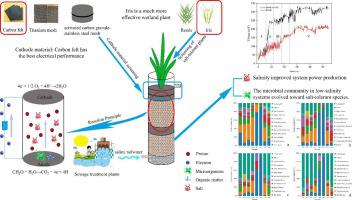Efficacy and power production performance of constructed wetlands coupled with microbial fuel cells for the advanced treatment of saline tailwater from wastewater treatment plants
IF 6.3
2区 工程技术
Q1 ENGINEERING, CHEMICAL
引用次数: 0
Abstract
In this study, the effects of different electrode materials and salt-tolerant plants on the efficacy and power production performance of constructed wetlands coupled microbial fuel cells (CW-MFCs) were analyzed for the advanced treatment of saline tailwater from wastewater treatment plants (WWTPs). The results showed that when carbon felt was used as the cathode material, the voltage was 165.45 ± 14.90 mV after system stabilization, the maximum power density was 3.20 mW/m when the current density was 25.58 mA/m, and the power production performance of carbon felt was better than that of common titanium mesh and granular activated carbon-stainless steel mesh cathode materials ( < 0.05). When the two groups of systems were operated and stabilized, the average removal rates of TN, TP, NH-N and COD in RS-CW-MFC were 86.48 %, 88.1 %, 82.67 % and 88.96 %, respectively, and those of TN, TP, NH-N and COD in RN-CW-MFC were 84.33 %, 87.34 %, 81.63 % and 87.64 %, respectively. Salinity enhanced the power production efficiency by increasing ionic strength and decreasing the internal resistance of the system. The microbial community in the saline tailwater systems gradually evolved toward salt-tolerant species, which enhanced the power production efficiency of the system without affecting the treatment of traditional pollutants in the CW-MFC systems.

建构湿地与微生物燃料电池结合用于污水处理厂含盐尾水高级处理的功效和发电性能
本研究分析了不同电极材料和耐盐植物对构建湿地耦合微生物燃料电池(CW-MFCs)的功效和发电性能的影响,用于污水处理厂(WWTPs)含盐尾水的高级处理。结果表明,当使用碳毡作为阴极材料时,系统稳定后的电压为 165.45 ± 14.90 mV,当电流密度为 25.58 mA/m 时,最大功率密度为 3.20 mW/m,碳毡的发电性能优于普通钛网和颗粒活性碳-不锈钢网阴极材料(< 0.05)。两组系统运行稳定后,RS-CW-MFC 对 TN、TP、NH-N 和 COD 的平均去除率分别为 86.48%、88.1%、82.67% 和 88.96%,RN-CW-MFC 对 TN、TP、NH-N 和 COD 的平均去除率分别为 84.33%、87.34%、81.63% 和 87.64%。盐度通过增加离子强度和降低系统内阻提高了发电效率。含盐尾水系统中的微生物群落逐渐向耐盐物种演化,从而提高了系统的发电效率,但并不影响 CW-MFC 系统对传统污染物的处理。
本文章由计算机程序翻译,如有差异,请以英文原文为准。
求助全文
约1分钟内获得全文
求助全文
来源期刊

Journal of water process engineering
Biochemistry, Genetics and Molecular Biology-Biotechnology
CiteScore
10.70
自引率
8.60%
发文量
846
审稿时长
24 days
期刊介绍:
The Journal of Water Process Engineering aims to publish refereed, high-quality research papers with significant novelty and impact in all areas of the engineering of water and wastewater processing . Papers on advanced and novel treatment processes and technologies are particularly welcome. The Journal considers papers in areas such as nanotechnology and biotechnology applications in water, novel oxidation and separation processes, membrane processes (except those for desalination) , catalytic processes for the removal of water contaminants, sustainable processes, water reuse and recycling, water use and wastewater minimization, integrated/hybrid technology, process modeling of water treatment and novel treatment processes. Submissions on the subject of adsorbents, including standard measurements of adsorption kinetics and equilibrium will only be considered if there is a genuine case for novelty and contribution, for example highly novel, sustainable adsorbents and their use: papers on activated carbon-type materials derived from natural matter, or surfactant-modified clays and related minerals, would not fulfil this criterion. The Journal particularly welcomes contributions involving environmentally, economically and socially sustainable technology for water treatment, including those which are energy-efficient, with minimal or no chemical consumption, and capable of water recycling and reuse that minimizes the direct disposal of wastewater to the aquatic environment. Papers that describe novel ideas for solving issues related to water quality and availability are also welcome, as are those that show the transfer of techniques from other disciplines. The Journal will consider papers dealing with processes for various water matrices including drinking water (except desalination), domestic, urban and industrial wastewaters, in addition to their residues. It is expected that the journal will be of particular relevance to chemical and process engineers working in the field. The Journal welcomes Full Text papers, Short Communications, State-of-the-Art Reviews and Letters to Editors and Case Studies
 求助内容:
求助内容: 应助结果提醒方式:
应助结果提醒方式:


